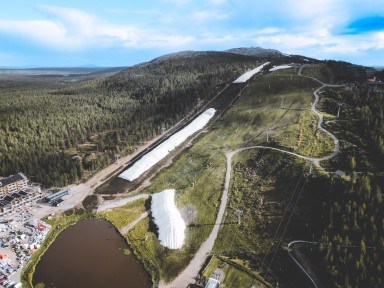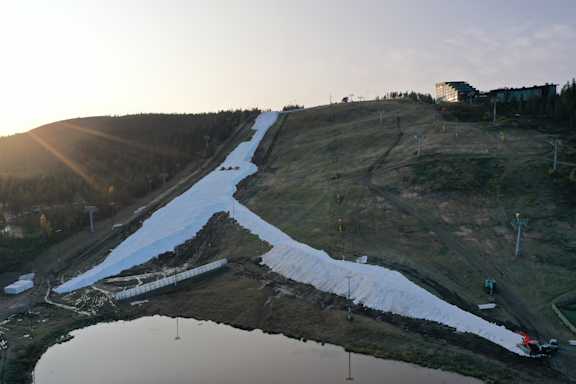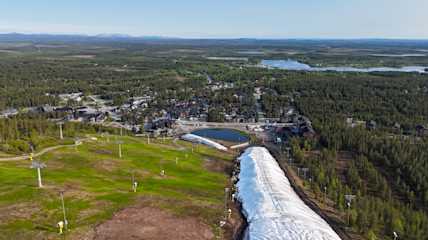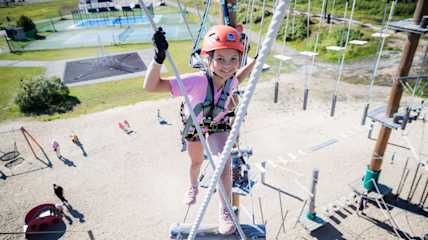
Snow recycling, technology and environmental impact
Snow cannoning is an integral part of every ski resort.
Snow cannoning starts in the autumn or the very beginning of winter when the temperatures drop permanently below freezing. Snow storage, saving and recycling snow from the previous winter season has become an important part of the snow infrastructure of Levi Ski Resort since it is cost-effective and more environmentally friendly.
Snow is created by blowing pressurised water into the air in below-freezing conditions, for example through blowers or long pressurised air ducts, which in turn crystallises into snow. Today Levi uses over 300 automatic snow cannons which can be controlled remotely through a digital network. Through advanced weather automation and remote controlling, these snow cannons can produce more snow with the same amounts of water and energy as before since they quickly react to fast changing weather on the fell such as wind direction. Automatic cannons are only on when the weather conditions are favourable for snow production at a specific slope.
The basis of snow cannoning on the slopes of Levi fell is in its vast snow cannon network with pipes that run underground around Levi fell itself to all the cannons installed there. The water is mainly pumped directly from Ounasjoki river, from where it can travel up to five kilometres through underground pipes all the way to the automatic cannons. All the automatic cannons have their own weather sensors which enables them to be optimised, such as in regards to the water pressure and amounts of water being let through the cannon. All cannons have their own threshold values regarding when the cannon is allowed to turn on and when it shuts off. This creates better quality snow and saves water.
Creating snow on the fell: wind and experience count
The weather conditions on the fell determine where snow cannoning can be done. One of the main factors in regards to cannoning is wind, especially after sub-zero temperatures. Snow cannoning can only be done with tailwinds and if the wind conditions are not right, cannons are not started. To outsiders it can seem strange that the cannons are not on evenly all throughout the fell, but that they can be on at different times in different parts of the fell. The most common reason for this is wind conditions.
Experience plays a major role in successful snow cannoning. Levi Ski Resort has an experienced team of regulars who can judge pretty well how much snow is needed on each slope area as well as keep an eye on each cannon’s water usage compared to previous years. When cannoning snow, the aim is not to create any more than is needed. Working like this saves energy as well as water, and in doing so it minimises meltwater in spring which in turn has an effect on slope erosion.
Technique of snow storage
The second most important part after energy-efficient snow cannoning is saving the snow. Storing snow is an environmentally friendly act since recycling and utilising the snow for the next season lessens the need for snow cannoning in the challenging conditions of early winter.
Some of the snow for next season is made with snow cannons around the end of January to the beginning of February when the conditions are at their coldest and most optimal. This way the least amount of water and energy are needed. After this, the snow is spread along the slope and, for safety reasons, slightly over the edge so as not to create steep sides.
After May Day when the ski resort closes, the snow is collected from the slopes into large mounds on different sides of the fell by the use of heavy machinery. The diggers mould the sides of the mounds so that they are jagged, tight parcels. Once this is all done, the mounds are covered up.
Major effect of the storage covers
In the early years, the mounds of snow were covered with heavy building sheets. These white, sun reflective sheets were cost-effective, since they could be re-used and they were environmentally friendly.
With the advancement of storage technology the Ski Resort invested in new covering sheets in 2020, which lowered the amounts of lost snow from around 30% to as low as 10%. This new Finnfoam-based insulation system has had a very significant positive ecological and financial impact. With traditional ways of storing snow the loss of mass during the summer from melting was between 20-60%.
When the autumn and cooler weather arrives, the coverings are taken off the mounds and the covers are stored rolled up waiting for the next springtime to arrive. The mounds of snow are spread with snow cats onto the slopes and on the cross country skiing trail. Levi Ski Resort has changed into using biofuel in all their machinery.
The Levi Glacier project is the peak of snow storing evolution
Levi Ski Resort stores snow to be used at the World Cup as well as for starting the downhill skiing season at the Front Slopes in October and the South-Eastern slopes for the beginning of skiing season.
The latest evolution of this snow storage process of the Glacier Project at the front slopes aims to make the storage process as efficient as possible when it comes to energy usage, as well as the amounts of staff and machinery that's needed. As part of the Glacier Project the Front Slope got a new ski lift during the summer of 2022 and the incline of the slope was amended significantly. As part of the Glacier Project, the Front Slopes have a joint snow storage area, in which the amount of stored snow is maximised and at the same time it minimises the melting percentage of snow stored there.
With the new chair lift, most of this stored snow will be utilised on the slope itself. Stored snow creates a good base for natural snowfall in the winter as well as new cannoned snow. All equipment on the slopes, the lifts and the snow cannons, are the most modern and energy efficient available.
Glacier stored snow base was created in early winter 2022-2023 and the Glacier stored-snow slope saw its first ski runs during the winter season opening on 6.10.2023.










